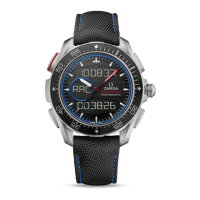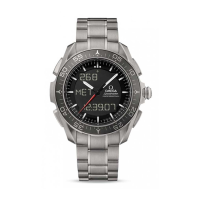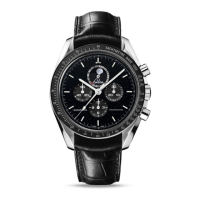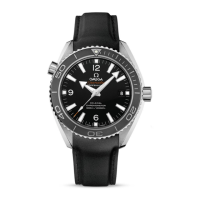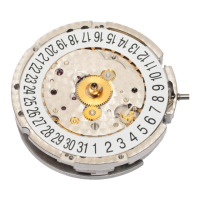Do you have a question about the Omega Speedmaster X-33 Marstimer and is the answer not in the manual?
Guidance on watch maintenance, care, and protection from environmental factors.
Information on product disposal according to environmental regulations.
Details on what the manufacturer's warranty covers and its limitations.
Procedures and conditions for submitting a warranty claim.
Explanation of the first digital display on the watch.
Explanation of the second digital display on the watch.
Explanation of the third digital display on the watch.
Identification of the hour hand on the watch.
Accessing a pre-set favourite function.
Activating the watch's digital display back-lighting.
Clearing watch hands for improved display visibility.
Entering or exiting programming modes.
Entering and operating in programming mode for functions.
Procedure for resetting a programmable watch function.
Overview of the UTC function and its corresponding page.
Overview of Time Zone 1 function and its corresponding page.
Overview of Time Zone 2 function and its corresponding page.
Overview of the Mission Elapsed Time function and its page.
Display of the current time in 24-hour format.
Display of the current date with perpetual calendar.
Watch display alternates between day of week and week number.
Increasing a value during UTC programming.
Confirming current setting and moving to the next.
Decreasing a value during UTC programming.
Exiting the UTC programming mode.
Display of the current date via perpetual calendar.
Indicates the selected Time Zone function.
Display of current time in 24-hour format.
Increasing a value during T1/T2 programming.
Confirming current setting and moving to the next.
Decreasing a value during T1/T2 programming.
Exiting the T1/T2 programming mode.
Display of the sol number within the Martian year.
Indicates the selected Martian Time Coordinated function.
Display of current time on Mars.
Display of Martian solar longitude.
Display of the sol number within the Martian year.
Indicates the selected Martian Time Zone function.
Display of current time on Mars.
Display of Martian solar longitude.
Increasing a value during M1/M2 programming.
Confirming current setting and moving to the next.
Decreasing a value during M1/M2 programming.
Exiting the M1/M2 programming mode.
Display shows remaining or elapsed days for a mission.
Indicates the selected Mission Elapsed Time function.
Display shows remaining or elapsed time for a mission.
Display of the mission start date.
Negative sign indicates a future event in MET.
Positive sign indicates a past event in MET.
Selecting reference time for MET programming.
Programming year, month, and day for MET.
Display of remaining or elapsed days for a phase.
Indicates the selected Phase Elapsed Time function.
Display of remaining or elapsed time for a phase.
Shows days difference between MET and deadline.
Selecting reference time for PET programming.
Relative programming settings based on MET.
Programming the number of days for PET.
Programming hours, minutes, and seconds for PET.
Absolute programming settings for PET.
Programming date and time for UTC, T1, T2.
Programming Martian time units for MTC, M1, M2.
Programming Martian solar longitude for MLS.
Display of alarm activation status.
Indicates the selected Alarm function.
Display of the programmed alarm time.
Display of the next alarm activation date.
Increasing a value during alarm programming.
Confirming current setting and moving to the next.
Decreasing a value during alarm programming.
Exiting the alarm programming mode.
Indicator showing when the chronograph is stopped.
Indicator showing when a split time is recorded.
Indicates the selected Chronograph function.
Display of the measured time by the chronograph.
Starting or stopping the chronograph timing.
Displaying recorded split times.
Resetting the chronograph to zero.
Display during or before the timer countdown.
Display after the timer countdown has finished.
Display of programmed days for the timer.
Indicates the selected Timer function.
Procedure to enter the Timer function.
Entering programming mode for the timer.
Increasing a value during timer programming.
Confirming current setting and moving to the next.
Starting or stopping the timer countdown.
Stopping or restarting the timer from the displayed time.
Resetting the timer to zero.
Display of the current date.
Indicates the selected True Solar Time (Earth) function.
Display of the true solar time.
Display alternates between longitude and latitude.
Procedure to display STE function after selecting T function.
Procedure to display STM function after selecting M1 function.
Entering programming mode for STE/STM.
Parameters for STE programming: longitude and latitude.
Exiting the STE/STM programming mode.
Procedure to determine North and display LTST using STE/STM.
Procedure to exit the STE or STM function.
Activating and exiting the energy saving mode.
Procedure for manually synchronizing watch hands.
Clearing watch hands for improved display visibility.
Saving and accessing a favourite function using pusher P4.
Assigning a function to pusher P4 as a favourite.
Switching between favourite and last displayed functions.
Chime sequences for alarms and functions.
Rules for handling multiple simultaneous chimes.
Setting time zones for trip planning (T1, T2).
Programming specific functions for trip planning.
Programming time zones for a Mars voyage.
Defining UTC as the reference time zone.
Setting T1 for the current location's time zone.
Setting T2 for launch location time zone.
Programming functions for rocket take-off phases.
Programming functions for the landing phase of a mission.
Programming Martian time zone after landing.
Troubleshooting desynchronized watch hands.
Troubleshooting seconds hand jumping due to low battery.
Troubleshooting zero count after MET/PET programming.
Guidance on watch maintenance, care, and protection from environmental factors.
Information on product disposal according to environmental regulations.
Details on what the manufacturer's warranty covers and its limitations.
Procedures and conditions for submitting a warranty claim.
Explanation of the first digital display on the watch.
Explanation of the second digital display on the watch.
Explanation of the third digital display on the watch.
Identification of the hour hand on the watch.
Accessing a pre-set favourite function.
Activating the watch's digital display back-lighting.
Clearing watch hands for improved display visibility.
Entering or exiting programming modes.
Entering and operating in programming mode for functions.
Procedure for resetting a programmable watch function.
Overview of the UTC function and its corresponding page.
Overview of Time Zone 1 function and its corresponding page.
Overview of Time Zone 2 function and its corresponding page.
Overview of the Mission Elapsed Time function and its page.
Display of the current time in 24-hour format.
Display of the current date with perpetual calendar.
Watch display alternates between day of week and week number.
Increasing a value during UTC programming.
Confirming current setting and moving to the next.
Decreasing a value during UTC programming.
Exiting the UTC programming mode.
Display of the current date via perpetual calendar.
Indicates the selected Time Zone function.
Display of current time in 24-hour format.
Increasing a value during T1/T2 programming.
Confirming current setting and moving to the next.
Decreasing a value during T1/T2 programming.
Exiting the T1/T2 programming mode.
Display of the sol number within the Martian year.
Indicates the selected Martian Time Coordinated function.
Display of current time on Mars.
Display of Martian solar longitude.
Display of the sol number within the Martian year.
Indicates the selected Martian Time Zone function.
Display of current time on Mars.
Display of Martian solar longitude.
Increasing a value during M1/M2 programming.
Confirming current setting and moving to the next.
Decreasing a value during M1/M2 programming.
Exiting the M1/M2 programming mode.
Display shows remaining or elapsed days for a mission.
Indicates the selected Mission Elapsed Time function.
Display shows remaining or elapsed time for a mission.
Display of the mission start date.
Negative sign indicates a future event in MET.
Positive sign indicates a past event in MET.
Selecting reference time for MET programming.
Programming year, month, and day for MET.
Display of remaining or elapsed days for a phase.
Indicates the selected Phase Elapsed Time function.
Display of remaining or elapsed time for a phase.
Shows days difference between MET and deadline.
Selecting reference time for PET programming.
Relative programming settings based on MET.
Programming the number of days for PET.
Programming hours, minutes, and seconds for PET.
Absolute programming settings for PET.
Programming date and time for UTC, T1, T2.
Programming Martian time units for MTC, M1, M2.
Programming Martian solar longitude for MLS.
Display of alarm activation status.
Indicates the selected Alarm function.
Display of the programmed alarm time.
Display of the next alarm activation date.
Increasing a value during alarm programming.
Confirming current setting and moving to the next.
Decreasing a value during alarm programming.
Exiting the alarm programming mode.
Indicator showing when the chronograph is stopped.
Indicator showing when a split time is recorded.
Indicates the selected Chronograph function.
Display of the measured time by the chronograph.
Starting or stopping the chronograph timing.
Displaying recorded split times.
Resetting the chronograph to zero.
Display during or before the timer countdown.
Display after the timer countdown has finished.
Display of programmed days for the timer.
Indicates the selected Timer function.
Procedure to enter the Timer function.
Entering programming mode for the timer.
Increasing a value during timer programming.
Confirming current setting and moving to the next.
Starting or stopping the timer countdown.
Stopping or restarting the timer from the displayed time.
Resetting the timer to zero.
Display of the current date.
Indicates the selected True Solar Time (Earth) function.
Display of the true solar time.
Display alternates between longitude and latitude.
Procedure to display STE function after selecting T function.
Procedure to display STM function after selecting M1 function.
Entering programming mode for STE/STM.
Parameters for STE programming: longitude and latitude.
Exiting the STE/STM programming mode.
Procedure to determine North and display LTST using STE/STM.
Procedure to exit the STE or STM function.
Activating and exiting the energy saving mode.
Procedure for manually synchronizing watch hands.
Clearing watch hands for improved display visibility.
Saving and accessing a favourite function using pusher P4.
Assigning a function to pusher P4 as a favourite.
Switching between favourite and last displayed functions.
Chime sequences for alarms and functions.
Rules for handling multiple simultaneous chimes.
Setting time zones for trip planning (T1, T2).
Programming specific functions for trip planning.
Programming time zones for a Mars voyage.
Defining UTC as the reference time zone.
Setting T1 for the current location's time zone.
Setting T2 for launch location time zone.
Programming functions for rocket take-off phases.
Programming functions for the landing phase of a mission.
Programming Martian time zone after landing.
Troubleshooting desynchronized watch hands.
Troubleshooting seconds hand jumping due to low battery.
Troubleshooting zero count after MET/PET programming.
| Brand | Omega |
|---|---|
| Model | Speedmaster X-33 Marstimer |
| Category | Watch |
| Movement | Quartz |
| Case Material | Titanium |
| Case Diameter | 45 mm |
| Dial Color | Black |
| Crystal | Sapphire |
| Strap Material | Titanium |
| Display | Analog-Digital |
| Caliber | 5622 |
| Water Resistance | 30 meters |
| Functions | Chronograph, Alarm, GMT |
| Bracelet | Titanium |
| Battery Life | 24 months |
